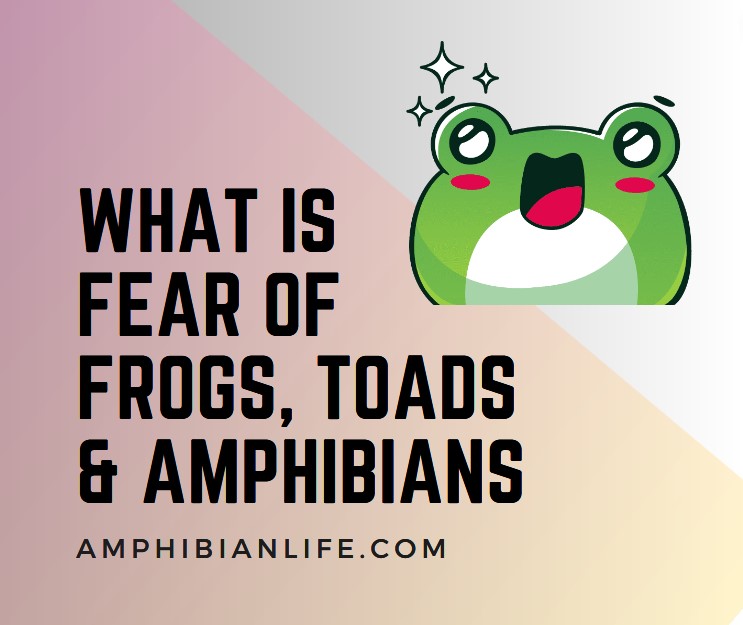
Overcoming Ranidaphobia and Batrachophobia: Conquering Amphibian Fear
Phobias, those intense and irrational fears, have the power to significantly impact an individual’s life. While some fears may be common and manageable, others are deeply specific and can feel overwhelming. In this article, we explore two related phobias—ranidaphobia and batrachophobia—both of which center around an intense fear of frogs and amphibians.
Understanding Ranidaphobia and Batrachophobia
Ranidaphobia is the fear of frogs, while batrachophobia extends to include all amphibians. These phobias can result in significant anxiety, avoidance behaviors, and a diminished quality of life for those who experience them. Here, we’ll delve into the nature of these phobias, their symptoms, potential causes, and, most importantly, strategies to overcome them.
A person who is scared of frogs and toads may recognise that the fear is illogical, yet he or she cannot control it. Ranidaphobia is related to batrachophobia, which is the fear of amphibians such as frogs, toads, newts, salamanders, and others. Bufonophobia is a fear of toads in particular.
What Is Ranidaphobia: The Fear of Frogs
Defining Ranidaphobia
Ranidaphobia, an uncommon but impactful phobia, is characterized by an intense and irrational fear of frogs. Individuals with ranidaphobia may experience severe anxiety, panic attacks, or avoidance behavior when confronted with frogs, whether real or in images, videos, or stories.
Recognizing the Symptoms
Symptoms of ranidaphobia can vary from person to person but often include increased heart rate, rapid breathing, trembling, sweating, nausea, and a strong desire to escape the perceived threat (in this case, frogs).
The Impact on Daily Life
Ranidaphobia can have a profound impact on daily life. Activities that involve outdoor exploration, nature walks, or even visiting bodies of water may be off-limits to individuals with this fear. Understanding the causes and triggers of ranidaphobia is a crucial step toward recovery.
What Is Batrachophobia: The Fear of Amphibians
Understanding Batrachophobia
Batrachophobia is a broader phobia that encompasses an irrational fear of all amphibians, not just frogs. Individuals with batrachophobia may exhibit anxiety, panic attacks, or avoidance behavior when encountering amphibians, which can include frogs, toads, newts, and salamanders.
Identifying Batrachophobia Symptoms
Like ranidaphobia, batrachophobia can manifest with symptoms such as increased heart rate, trembling, sweating, and a strong desire to escape. The fear may extend to images, videos, or even discussions involving amphibians.
How It Affects Your Life
Batrachophobia can significantly impact an individual’s life, limiting their engagement in outdoor activities, travel, or even interactions with friends and family who may not fully understand the extent of the fear. Finding effective strategies to cope with and eventually overcome batrachophobia is essential.
The Roots of Ranidaphobia and Batrachophobia
Childhood Experiences
The origins of ranidaphobia and batrachophobia can vary widely. For some, traumatic childhood experiences involving amphibians or frightening encounters may be the catalyst for these fears. Childhood memories and emotions often play a significant role in the development of specific phobias.
Cultural Influences
Cultural influences can also contribute to these phobias. Folktales, stories, or cultural beliefs about amphibians can create negative associations and reinforce fear. Understanding the cultural context of your fear can be a key step in addressing it.
Biological Factors
Biological factors, such as genetics and brain chemistry, can also play a role in the development of phobias. Some individuals may be more predisposed to developing specific phobias, including those related to frogs and amphibians, due to their genetic makeup.
Confronting Your Fear: Steps to Recovery
Self-Reflection and Acceptance
The journey to overcoming ranidaphobia and batrachophobia often begins with self-reflection and acceptance. Acknowledge your fear, its impact on your life, and your desire for change. Recognize that it’s okay to seek help and support.
Education and Awareness
Gaining knowledge about frogs and amphibians is a powerful tool in overcoming these phobias. Learning about their behaviors, habitats, and the role they play in ecosystems can demystify these creatures and reduce fear.
Gradual Exposure Therapy
Gradual exposure therapy is a commonly used technique for phobia treatment. Under the guidance of a therapist, individuals are exposed to their feared objects or situations in a controlled and gradual manner. This exposure allows the individual to become more comfortable and less anxious over time.
Cognitive-Behavioral Therapy (CBT)
Cognitive-Behavioral Therapy (CBT) is another effective approach. In CBT, individuals work with a therapist to identify and challenge irrational beliefs and thought patterns associated with their phobia. This therapy can help change negative thought processes into more positive and rational ones.
Self-Help Techniques to Overcome Ranidaphobia and Batrachophobia
Relaxation Techniques
Practicing relaxation techniques, such as deep breathing, meditation, or progressive muscle relaxation, can help manage anxiety associated with these phobias. These techniques can be especially useful during exposure therapy or when confronting your fear.
Visualization and Guided Imagery
Visualization and guided imagery involve mentally rehearsing encounters with frogs or amphibians in a calm and controlled manner. These techniques can desensitize your mind to the fear and reduce anxiety.
Mindfulness and Meditation
Mindfulness and meditation techniques can teach you to stay present and non-judgmental in the face of your fear. By focusing on the here and now, you can reduce the power of irrational thoughts and anxiety.
Building a Support System
Don’t underestimate the value of a strong support system. Friends, family, or support groups can provide encouragement, understanding, and a safe space to discuss your phobia. Sharing your experiences and progress can be therapeutic.
Seek Professional Help: Therapies and Medications
Exposure Therapy
Exposure therapy, when conducted by a trained therapist, can be highly effective in treating ranidaphobia and batrachophobia. Therapists create a safe and controlled environment for exposure, gradually helping individuals confront their fears.
Cognitive Restructuring
Cognitive restructuring, a key component of CBT, involves challenging and reframing irrational beliefs about amphibians and frogs. Therapists assist individuals in developing healthier and more rational thought patterns.
Medications for Anxiety Disorders
In some cases, medications may be prescribed to manage the anxiety symptoms associated with these phobias. These medications, such as selective serotonin reuptake inhibitors (SSRIs), can help reduce anxiety and make it easier to engage in therapy.
Coping Strategies for Daily Life
Outdoor Activities and Nature
Gradually reintroduce outdoor activities and nature walks into your life. Start with environments where you’re less likely to encounter frogs or amphibians, and gradually increase exposure. Remember to use the relaxation techniques you’ve learned.
Traveling and Outdoor Adventures
If you love traveling and outdoor adventures, don’t let your phobia hold you back. Research your destination and plan activities that minimize potential encounters with amphibians. Stay prepared and focused on enjoying your trip.
Handling Encounters with Frogs and Amphibians
Should you encounter frogs or amphibians unexpectedly, remember your coping techniques. Practice deep breathing, mindfulness, or visualization to stay calm. Over time, these encounters will become less distressing.
Success Stories: Real-Life Experiences
Hearing about the experiences of others who have successfully overcome ranidaphobia and batrachophobia can be incredibly inspiring. Real-life success stories illustrate that recovery is possible and offer valuable insights into the process.
Conclusion: Embrace the Journey to Recovery
In conclusion, ranidaphobia and batrachophobia, the fears of frogs and amphibians, can be challenging, but they are conquerable. By seeking help, using self-help techniques, and gradually confronting your fear, you can regain control over your life and embrace the world of frogs and amphibians with newfound confidence. The journey to recovery may have its ups and downs, but each step forward brings you closer to a life free from the limitations of these phobias.
